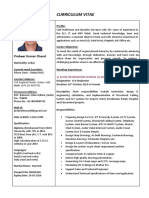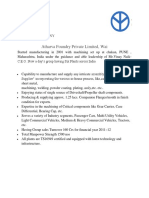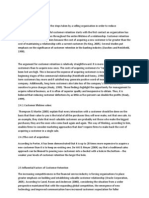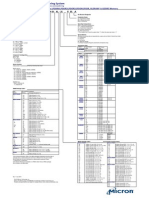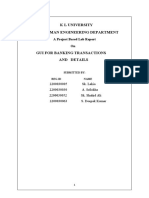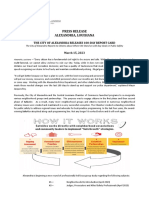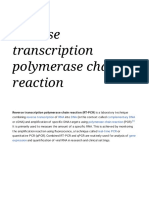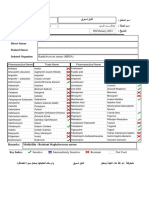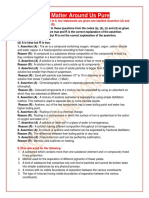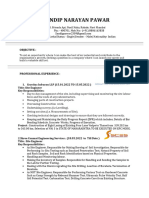DNA extraction
The first isolation of deoxyribonucleic acid (DNA) was done in 1869 by Friedrich Miescher.
[1]
Currently it is a routine procedure in molecular biology or forensic analyses. For the chemical
method, there are many different kits used for extraction, and selecting the correct one willsave time on kit optimization and extraction procedures. PCR sensitivity detection isconsidered to show the variation between the commercial kits.
[2]
Cells which are to be studied need to be collected.
Breaking the cell membranes open to expose the DNA along with the cytoplasm within(cell lysis).Lipids from the cell membrane and the nucleus are broken down with detergents andsurfactants.Breaking down proteins by adding a protease (optional).
Breaking down RNA by adding an RNase (optional).
The solution is treated with a concentrated salt solution (saline) to make debris such asbroken proteins, lipids and RNA clump together.Centrifugation of the solution, which separates the clumped cellular debris from the DNA.DNA purification from detergents, proteins, salts and reagents used during the cell lysisstep. The most commonly used procedures are:Ethanol precipitation usually by ice-cold ethanol or isopropanol. Since DNA is insoluble
in these alcohols, it will aggregate together, giving a
pellet
upon centrifugation.Precipitation of DNA is improved by increasing of ionic strength, usually by addingsodium acetate.
Basic procedure

Phenol–chloroform extraction in which phenol denatures proteins in the sample. After
centrifugation of the sample, denatured proteins stay in the organic phase while theaqueous phase containing nucleic acid is mixed with chloroform to remove phenol
residues from the solution.Minicolumn purification that relies on the fact that the nucleic acids may bind
(adsorption) to the solid phase (silica or other) depending on the pH and the salt
concentration of the buffer.Cellular and histone proteins bound to the DNA can be removed either by adding a protease or
by having precipitated the proteins with sodium or ammonium acetate, or extracted them
with a phenol-chloroform mixture prior to the DNA-precipitation.After isolation, the DNA is dissolved in a slightly alkaline buffer, usually in a TE buffer, or inultra-pure water.Some of the most common DNA extraction methods include organic extraction, Chelex
extraction, and solid phase extraction.
[3]
These methods consistently yield isolated DNA, butthey differ in both the quality and the quantity of DNA yielded. When selecting a DNAextraction method, there are multiple factors to consider, including cost, time, safety, and riskof contamination.Organic extraction involves the addition of and incubation in multiple different chemicalsolutions;
[3]
including a lysis step, a phenol chloroform extraction, an ethanol precipitation, and
washing steps. Organic extraction is often used in laboratories because it is cheap, and ityields large quantities of pure DNA. Though it is easy, there are many steps involved, and ittakes longer than other methods. It also involves the unfavorable use of the toxic chemicalsphenol and chloroform, and there is an increased risk of contamination due to transferring the
DNA between multiple tubes.
[4]
Several protocols based on organic extraction of DNA wereeffectively developed decades ago,
[5]
though improved and more practical versions of theseprotocols have also been developed and published in the last years.
[6]
Chelex extraction method involves adding the Chelex resin to the sample, boiling the solution,then vortexing and centrifuging it. The cellular materials bind to the Chelex beads, while theDNA is available in the supernatant.
[4]
The Chelex method is much faster and simpler thanorganic extraction, and it only requires one tube, which decreases the risk of DNAcontamination. Unfortunately, Chelex extraction does not yield as much quantity and the DNA
Method selection
yielded is single-stranded, which means it can only be used for PCR-based analyses and notfor RFLP.
[4]
Solid phase extraction such as using a spin-column based extraction method takes advantage
of the fact that DNA binds to silica. The sample containing DNA is added to a columncontaining a silica gel or silica beads and chaotropic salts. The chaotropic salts disrupt thehydrogen bonding between strands and facilitate binding of the DNA to silica by causing thenucleic acids to become hydrophobic. This exposes the phosphate residues so they areavailable for adsorption.
[7]
The DNA binds to the silica, while the rest of the solution iswashed out using ethanol to remove chaotropic salts and other unnecessary constituents.
[3]
The DNA can then be rehydrated with aqueous low salt solutions allowing for elution of theDNA from the beads.This method yields high-quality, largely double-stranded DNA which can be used for both PCRand RFLP analysis. This procedure can be automated
[4]
and has a high throughput, althoughlower than the phenol-chloroform method. This is a one-step method i.e the entire procedureis completed in one tube. This lowers the risk of contamination making it very useful forforensic extraction of DNA. Multiple solid phase extraction commercial kits are manufacturedand marketed by different companies; the only problem is that they are more expensive thanorganic extraction or Chelex extraction.Specific techniques must be chosen for isolation of DNA from some samples. Typicalsamples with complicated DNA isolation are:archaeological samples containing partially degraded DNA, see ancient DNA
[8]
samples containing inhibitors of subsequent analysis procedures, most notably inhibitors ofPCR, such as humic acid from soil, indigo and other fabric dyes or haemoglobin in blood
samples from microorganisms with thick cellular wall, for example yeastsamples containing mixed DNA from multiple sourcesExtrachromosomal DNA is generally easy to isolate, especially plasmids may be easilyisolated by cell lysis followed by precipitation of proteins, which traps chromosomal DNA ininsoluble fraction and after centrifugation, plasmid DNA can be purified from soluble fraction.A Hirt DNA Extraction is an isolation of all extrachromosomal DNA in a mammalian cell. TheHirt extraction process gets rid of the high molecular weight nuclear DNA, leaving only lowmolecular weight mitochondrial DNA and any viral episomes present in the cell.
Special types
A diphenylamine (DPA) indicator will confirm the presence of DNA. This procedure involveschemical hydrolysis of DNA: when heated (e.g. ≥95 °C) in acid, the reaction requires adeoxyribose sugar and therefore is specific for DNA. Under these conditions, the 2-deoxyribose is converted to w-hydroxylevulinyl aldehyde, which reacts with the compound,diphenylamine, to produce a blue-colored compound. DNA concentration can be determinedmeasuring the intensity of absorbance of the solution at the 600 nm with aspectrophotometer and comparing to a standard curve of known DNA concentrations.
Measuring the intensity of absorbance of the DNA solution at wavelengths 260 nm and 280nm is used as a measure of DNA purity. DNA can be quantified by cutting the DNA with arestriction enzyme, running it on an agarose gel, staining with ethidium bromide (EtBr) or a
different stain and comparing the intensity of the DNA with a DNA marker of knownconcentration.Using the Southern blot technique, this quantified DNA can be isolated and examined furtherusing PCR and RFLP analysis. These procedures allow differentiation of the repeated
sequences within the genome. It is these techniques which forensic scientists use forcomparison, identification, and analysis.In this method, plant nuclei are isolated by physically grinding tissues and reconstituting theintact nuclei in a unique Nuclear Isolation Buffer (NIB). The plastid DNAs are released fromorganelles and eliminated with an osmotic buffer by washing and centrifugation. The purifiednuclei are then lysed and further cleaned by organic extraction, and the genomic DNA isprecipitated with a high concentration of CTAB. The highly pure, high molecular weight gDNAis extracted from the nuclei, dissolved in a high pH buffer, allowing for stable long-termstorage.
[9]
Boom methodDNA fingerprintingDNA sequencingDNA structure
Detection of DNAHigh-molecular-weight DNA extraction methodSee also










